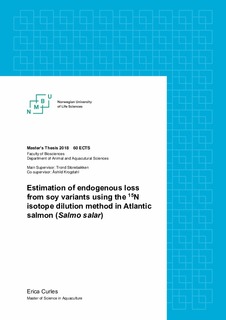| dc.description.abstract | True digestibility of feeds and feed ingredients is difficult to measure in fish, partially due to methodological challenges in quantifying endogenous losses that are mixed with undigested materials originating from the feed. This difficulty is why apparent digestibility, not corrected for the endogenous losses, is predominantly used to evaluate the quality of animal feeds. Endogenous loss has historically been estimated with several different methods to attempt to determine true digestibility. This study used the 15N-isotope dilution method, which involves enriching the feed or the animal’s tissues with an isotope, in this case nitrogen-15, and then measuring the nitrogen-15 in the excreted material. This isotope dilution method has been used in pigs and rats to calculate true digestibility. However, it has never been used to measure endogenous losses in fish. Soy is a common feed ingredient that may result in high endogenous loss, partially due to the Kunitz and Bowman-Birk protease inhibitors that inhibit hydrolysis by binding to the active site of digestive enzymes and prevent both enzyme and inhibitor from being absorbed. Candida utilis was chosen to be the vehicle for 15N due to its known palatability to salmon, favorable amino acid profile, and suitability for fast, high density culture. Over one kilogram of yeast was grown in a 42 l fermenter using a 24-hour fed-batch fermentation protocol. The yeast was labeled by replacing 35.3% of the required ammonium sulfate with ( 15NH4)2SO4. The 15N-enriched C. utilis was incorporated into a feed where it was the sole protein source, and this feed was given to Atlantic salmon fingerlings to label their tissues. The labeled fingerlings were then fed 3 diets with varying expected levels of protease inhibition: a diet with C. utilis as the sole protein source, a 30% commercial soy diet, and a diet containing 30% triple null soy, a strain of soy that lacks the Kunitz protease inhibitor. No high temperature treatment was employed during feed processing, in order to maintain activity of the protease inhibitors in soy. The percentages of 15N in the feces and in the muscle and pyloric caeca were analyzed. Endogenous loss was calculated using the isotope dilution equation with both muscle and pyloric caeca as the 15N pool. The muscle was enriched in 15N by a factor of approximately 5 times, while the pyloric caeca was enriched by a factor of approximately 25 times. The percentage of 15N in the muscle did not significantly change while the fish were fed unlabeled feeds, while the percentage of 15N in the pyloric caeca decreased quickly. Both the corrected feces 15N percentages and the endogenous nitrogen losses partially matched the expected pattern with the commercial soy-fed fish having higher values than both the triple null soy- and yeast-fed. The diet comprised of 30% commercial soy caused approximately double the endogenous nitrogen loss of the diet with yeast as the sole protein source. The diet made with 30% triple null soy did not cause significantly more endogenous nitrogen loss than the yeast diet. This was unexpected because the triple null soy still contained the Bowman-Birk protease inhibitor while the yeast diet was not intended to contain protease inhibitors. The main point of contention when using the isotope dilution method is whether the chosen source for 15N (i.e. plasma, tissue type, organ) is representative of the amount of 15N secreted into the digestive system. Using whole pyloric caeca has not been attempted before. The results indicate that whole pyloric caeca may be a relatively accurate source pool for endogenous loss of enzymes, such as trypsin and chymotrypsin, that are secreted by the pancreatic tissue embedded in the pyloric caeca. The endogenous loss calculated with the isotope dilution equation can be used to calculate true digestibility by subtracting the endogenous nitrogen from the total fecal nitrogen. The data obtained on pyloric caeca uptake and loss from this study were sufficient to rank the endogenous losses of the diets but not sufficient to accurately use it as a 15N source pool. This means that any estimate of true digestibility from this data alone would likely be inaccurate. To increase the accuracy of true digestibility estimates using pyloric caeca as the source of 15N, further studies should be done using feeds with known true digestibilities and compare the digestibility estimated by using isotope dilution. An accurate regression model of the rate of loss of 15N from pyloric caeca should also be calculated using frequent sampling of labeled tissues while consuming an unlabeled simple (i.e. fishmeal) diet until the tissue returns to normal enrichment levels. | nb_NO |

